
Authors: Guedes-Alonso R, Santana-Viera S, Sosa-Ferrera Z, Santana-Rodríguez JJ
Article Title: Molecularly imprinted solid-phase extraction coupled with ultra high performance liquid chromatography and fluorescence detection for the determination of estrogens and their metabolites in wastewater.
Publication date: 2015
Journal: Journal of Separation Science
Volume: 38
Issue: (22)
Page numbers: 3961-3968.
DOI: 10.1002/jssc.201500764
Abstract: Estrogens are an important class of endocrine-disrupting compounds, and their contamination of environmental waters through the effluents of wastewater treatment plants could have an important impact on aquatic biota, even at low concentrations. For this reason, the development of selective and sensitive extraction methodologies, which permit the identification and quantification of these compounds at trace level concentrations, is very important. In this study, a quantitative method based on molecularly imprinted solid phase extraction coupled to ultra high performance liquid chromatography with fluorescence detection has been developed. It has been used for the simultaneous determination of three estrogens and two of their metabolites in water samples from wastewater treatment plants. The method developed presents satisfactory limits of detection (between 0.18 and 0.45 ng mL-1), good recoveries (higher than 60%) and low relative standard deviations (under 10%). The method was used to analyze wastewater from a veterinary hospital as well as influent and effluent samples of a wastewater treatment plant of Gran Canaria (Spain) The concentrations of the detected hormones ranged from 1.35 to 2.57 ng mL-1
Template and target information: estrogens, commercial MIP
Author keywords: estrogens, liquid chromatography, Molecularly imprinted polymers, Solid-phase extraction



Join the Society for Molecular Imprinting

New items RSS feed
Sign-up for e-mail updates:
Choose between receiving an occasional newsletter or more frequent e-mail alerts.
Click here to go to the sign-up page.
Is your name elemental or peptidic? Enter your name and find out by clicking either of the buttons below!
Other products you may like:
 MIPdatabase
MIPdatabase









